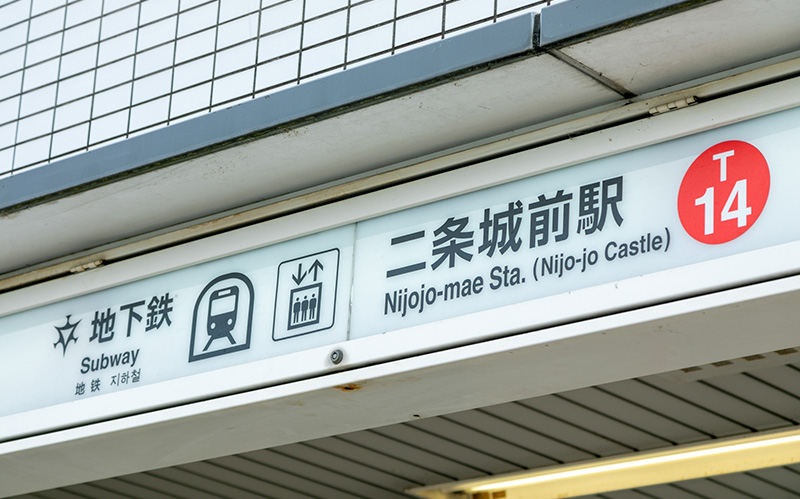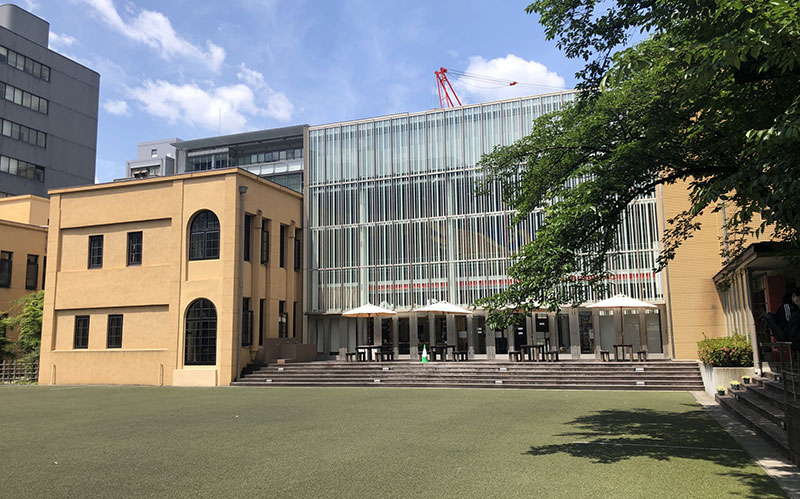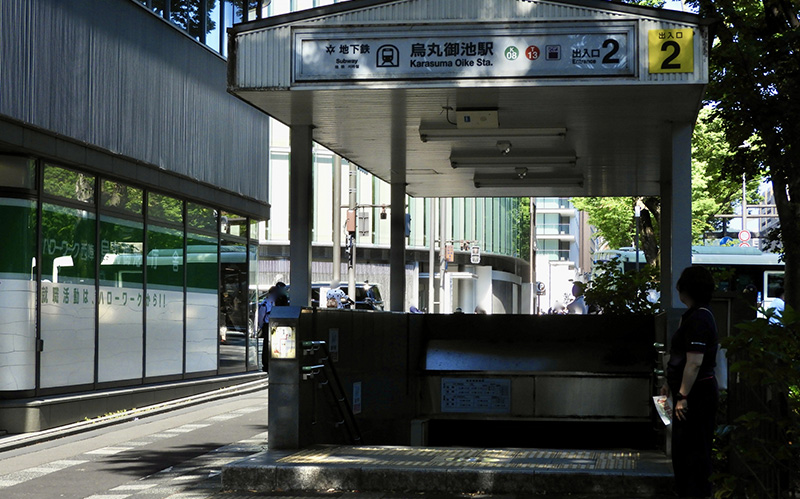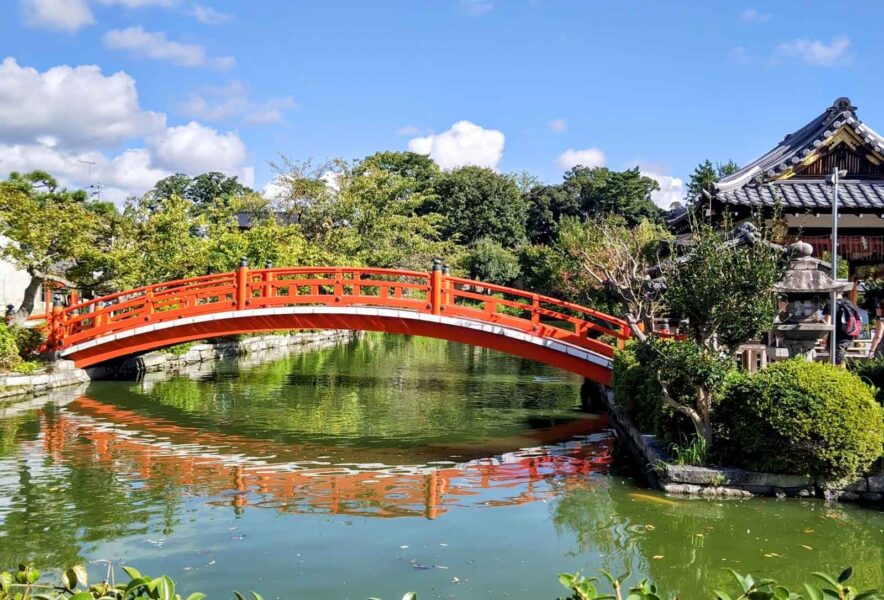Kyoto, once the imperial capital and now a city beloved worldwide, often captivates visitors with its historic streetscapes and traditional culture. Yet, it is also a thriving center of subculture.
On this walking tour, we’ll set out from Nijo Castle—where many domestic and international tourists gather—and make our way toward Karasuma Oike. Although this area is known as a tourist destination, it hides a number of lesser-known, off-the-beaten-path spots.
- Today’s Route: Kyoto Hidden Gems from Nijo Castle to Karasuma Oike
- Kyoto Walk: Starting from Nijo Castle to Discover Hidden Gems
- A. Kyoto Municipal Subway – Nijojo-mae Station
- B. Nijo Castle: Kyoto’s Flatland Castle, Witness to Centuries of History
- C. Shinsen’en: A Glimpse of Heian-Era Elegance
- D. Mikane Shrine: A Shrine for Good Financial Fortune
- E. Kyoto International Manga Museum: A Unique Manga Museum
- F. Kyoto Municipal Subway – Karasuma Oike Station
- Recap: A Walking Kyoto Tour from Nijo Castle to Karasuma Oike
- Kyoto Walk: Kyoto Stroll: Hidden Gems from Nijo Castle to Karasuma Oike
Today’s Route: Kyoto Hidden Gems from Nijo Castle to Karasuma Oike
A. (Start) Kyoto Municipal Subway – Nijojo-mae Station
B. Nijo Castle
C. Shinsen’en
D.Mikane Shrine
E. Kyoto International Manga Museum
F.(Goal) Kyoto Municipal Subway – Karasuma Oike Station
Kyoto Walk: Starting from Nijo Castle to Discover Hidden Gems
A. Kyoto Municipal Subway – Nijojo-mae Station

Our walk begins at Nijojo-mae Station on the Tozai Line. The station fronts Oshi-koji Street on the south side of Nijo Castle, creating a fascinating contrast between the surrounding residential neighborhood and the castle’s massive walls.

After exiting the station, head north along Horikawa Street, walking beside the castle moat as you make your way toward Nijo Castle. The sidewalk here is very wide, so even when it’s crowded with tourists you can still walk comfortably.
Continue north along this broad sidewalk, and you’ll soon see the Nijo Castle ticket office on your left.
B. Nijo Castle: Kyoto’s Flatland Castle, Witness to Centuries of History

In 1867, Tokugawa Yoshinobu handed political power back to the imperial court—an event known as the Taisei Hōkan—and it took place right here in Nijo Castle.
Completed in 1603 as Tokugawa Ieyasu’s residence, Nijo Castle still dazzles visitors with its ornate Karamon Gate, beautifully painted fusuma panels, and serene Japanese garden. Having stood through so many critical chapters of Japanese history, Nijo Castle is well worth a thorough exploration.

After finishing your ticket purchase at the reception, the first structure you’ll notice is the Higashi Ōtemon Gate (East Main Gate). Designated an Important Cultural Property, it was built in 1662. Passing through the ornate Karamon Gate—where you can almost feel the atmosphere of Momoyama-period artistry—brings you face-to-face with the Ninomaru Palace, a registered National Treasure.


With a separate ticket, you can tour the interior of the Ninomaru Palace. If you have the time, be sure to enter: the grand hall where Taisei Hōkan took place and the small waiting chamber called the Tonoshoin are particular highlights. Everywhere you look—on walls and sliding doors (fusuma)—you’ll see powerful, beautifully painted scenes that convey the weight and grandeur of Japanese history.

Beyond the Ninomaru Palace lies the Ninomaru Garden, a pristine example of a traditional Japanese landscape garden. From there, the path leads onward to the Honmaru Palace, though note that visiting the Honmaru Palace requires a prior reservation—if you’re interested, don’t forget to book in advance.

Nijo Castle’s grounds are quite extensive, and simply walking its perimeter can be tiring. Fortunately, there are rest areas scattered throughout, so feel free to pause and catch your breath as needed.
Once you’ve admired the palace buildings and the serene garden, it’s time to move on to the next stop. Exit through the same reception area where you entered, then head south. At the second traffic light, turn right onto Oike-dōri—which narrows just a bit here—and continue straight. After crossing the intersection, you’ll see Shinsen’en on your right, our next destination.

Nijo castle
541 Nijojo-cho, Nijo-dori Horikawa Nishi-iru, Nakagyo-ku, Kyoto 604-8301
Visit the official website here
C. Shinsen’en: A Glimpse of Heian-Era Elegance
The Heian period was when uniquely Japanese culture flourished, and Shinsen’en remains a living reminder of that graceful era.

The history of Shinsen’en dates back to 794, when the capital moved to Heian-kyō (modern Kyoto). At that time, it was created as a restricted imperial garden (“kin’en”) for the emperor’s use. The court held ceremonies and elegant banquets here. It is even said that Ōike Street—where we just walked—is named after the large pond within Shinsen’en’s grounds.

Shinsen’en is relatively compact, so it doesn’t take long to stroll around. Yet the grounds are imbued with the deep, quintessential beauty of the ancient capital. Stepping inside, you’ll feel as if you’ve entered the world of The Tale of Genji, allowing you to leave modern-day hustle behind.

Passing through the torii gate, you’ll immediately see the Zennyo Ryūō Shrine. To your right stands the Eho Shrine. Take a moment to calm your mind and offer your prayers before moving on.


Eho Shrine
Housed within Shinsen’en grounds, this small shrine is dedicated to the “Toshitokujin,” the Shinto deities believed to bring good fortune for the coming year. What makes Eho Shrine unique is its rare New Year’s Eve ritual: each year on December 31, locals turn the shrine’s building so that it faces the “lucky direction” (eho) for the next year. If you happen to be in Kyoto over New Year’s, it’s definitely worth witnessing this one-of-a-kind ceremony.

On your left, you’ll see the beautiful vermilion-painted Hōjō-bashi Bridge, which spans Hōjōju Pond. Legend has it that if you silently make a wish while crossing the bridge and then offer a prayer, your wish will come true.
While taking in Shinsen’en’s long history, let’s move on to our next destination—a rather unique shrine in Kyoto.
Exit Shinsen’en and turn left onto Ōike-dōri. Continue straight, crossing the busy Horikawa Street; although traffic here can be heavy, the wide sidewalks allow for a comfortable walk.
From Horikawa Street, count three blocks and turn left onto Nishinotōin Street. After a short distance, you’ll see Mikane Shrine on your right, marked by its distinctive golden torii gate.
Shinsen’en
166 Monzen-cho, Nakagyo-ku, Kyoto, 604-8306,
Visit the official website here
D. Mikane Shrine: A Shrine for Good Financial Fortune
With so much grim news these days, wouldn’t you want to visit a shrine believed to bring good financial fortune?
As you head north on Oike-dōri at Nishinotōin, you’ll spot a striking golden torii gate standing out among the surrounding apartment buildings and houses. This is Mikane Shrine, famed for bringing good financial fortune. Though it’s a small shrine, it’s become a popular spot with visitors coming one after another.

Although it’s a relatively new shrine, you can see how deeply it has been worshipped over the years.
Pass through the golden torii gate—its most distinctive feature—and prepare to pay your respects.

Behind the main hall straight ahead stands a ginkgo tree said to be 200 years old. This ginkgo is the sacred tree (goshinboku) of the shrine and appears as a motif on ema plaques and omamori charms. There are many cute designs, so if you’re interested, be sure to peek into the shamusho (shrine office).

Also, take note of the roof tiles and the shimenawa rope. The tiles are engraved with the character “金” (gold), and the shimenawa is gold-colored. Even the ema plaques are gilded, so golden accents gleam everywhere you look. It’s a rare sight, which makes the shrine feel all the more auspicious.

Once you’ve finished your prayers, head to the final destination. This time, we’ll switch gears and dive into a spot teeming with subculture.
Exit Mikane Shrine and turn left, then at the first intersection, turn right onto Oshikoji Street. This street is quite narrow, lined with traditional houses and shops, with the occasional stylish café or restaurant popping up as you walk. Be careful, as there is no sidewalk and traffic can be heavy.
Mikane Shrine
614 Oshi nishinotoin-cho, Nishinotoin-dori, Oike-agaru, Nakagyo-ku, 604-0042
Visit the official website here
E. Kyoto International Manga Museum: A Unique Manga Museum
The Kyoto International Manga Museum is a unique institution dedicated entirely to manga. It was jointly established by the city of Kyoto and Kyoto Seika University—renowned for its manga program. Housed in the former Elementary School, which closed in 1995, the museum retains the clean, modern-school atmosphere of its original buildings.

nside, the museum holds roughly 300,000 items in its collection. You’ll find everything from recent hit series to precious Edo-period caricatures and ukiyo-e prints. While some rare materials require advance reservations to view, manga and subculture enthusiasts will find it more than worth the trip.
Of those 300,000 works, about 50,000 are shelved along the famous “Manga Wall,” where anyone can freely browse and read. Rows upon rows of manga lining the entire wall create an absolutely breathtaking sight—perfect for discovering something new and diving into a fresh world.
If the weather is nice, step outside onto the beautifully manicured lawn for a breather. There’s also an on-site café, so you can grab a snack when you get peckish. Feel free to take any volume from the “Manga Wall” out onto the grass to read at your leisure.
The museum regularly holds special exhibitions and events, offering chances to see rare manuscripts and other materials that aren’t often on public display. If something piques your interest, be sure to check out an exhibition during your visit.
After you’ve immersed yourself in manga and revived your energy on the lawn or in the café, your stroll comes to a close—having explored a place where past and present manga culture coexist in one amazing space.
Kyoto International Manga Museum
Kinbuki cho 452, Nakagyo-ku, Kyoto city, 604-0846
Visit the official website here
F. Kyoto Municipal Subway – Karasuma Oike Station

Exit the Kyoto International Manga Museum and turn right. Head south along Karasuma Street, and after a short walk you’ll arrive at Karasuma Oike Station on the Kyoto Municipal Subway. This station serves both the Karasuma Line and the Tozai Line, making it incredibly convenient for sightseeing, commuting, or heading to school.
Karasuma Oike Station features a small underground shopping area called “Kotochika Oike.” Though compact, it offers cafés and a bookstore—perfect for picking up a manga you’ve had your eye on or enjoying a cup of coffee.
As a way to wrap up your stroll, why not spend a few moments here reflecting on the places you visited today?

Recap: A Walking Kyoto Tour from Nijo Castle to Karasuma Oike
※This walk includes some sites that require an admission fee.
A. (Start) Kyoto Municipal Subway – Nijojo-mae Station
↓ 210m
B. Nijo Castle
↓ 600m
C. Shinsen’en
↓ 750m
D.Mikane Shrine
↓ 500m
E. Kyoto International Manga Museum
↓ 160m
F.(Goal) Kyoto Municipal Subway – Karasuma Oike Station
